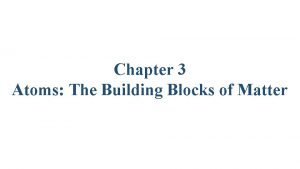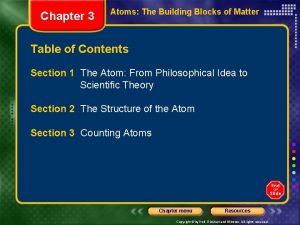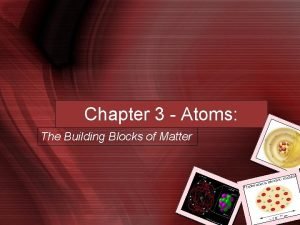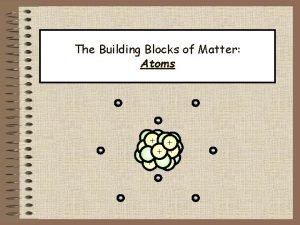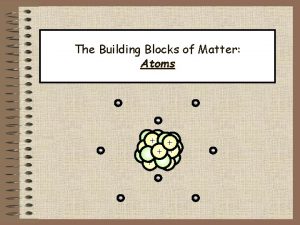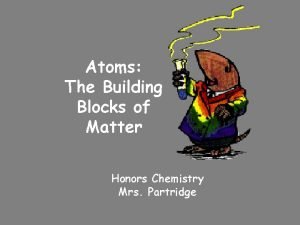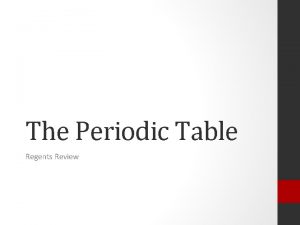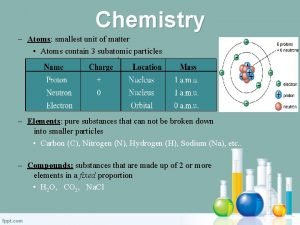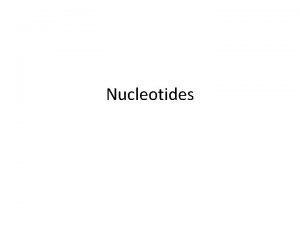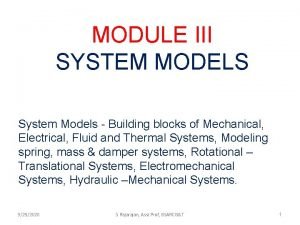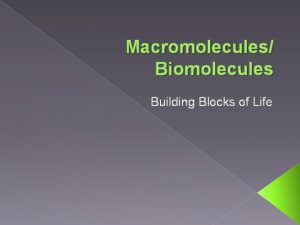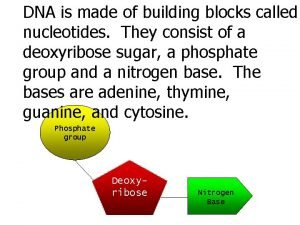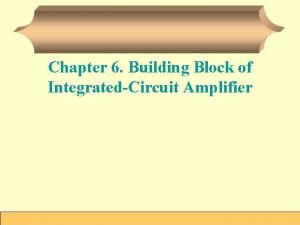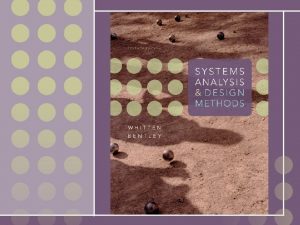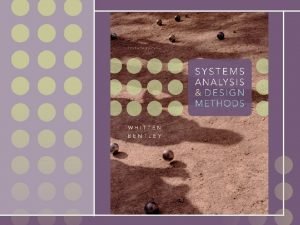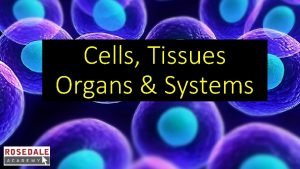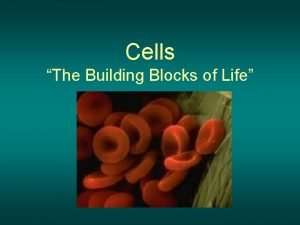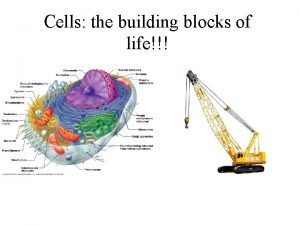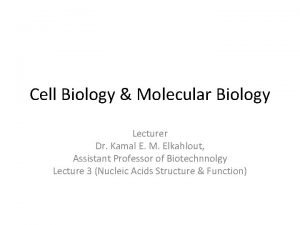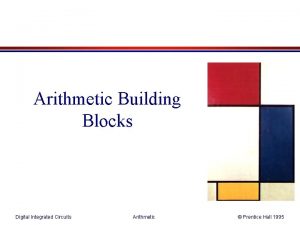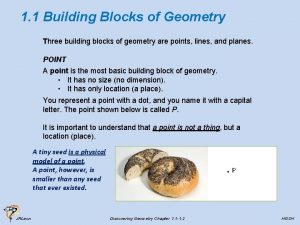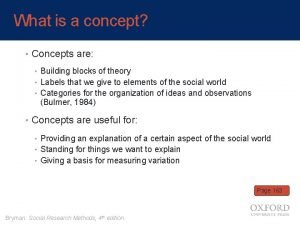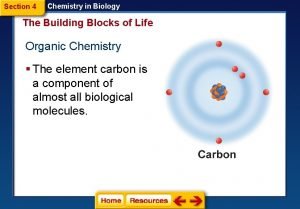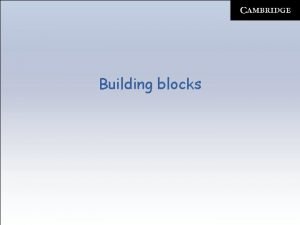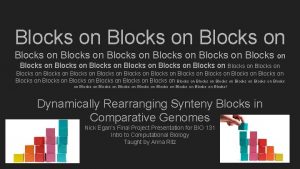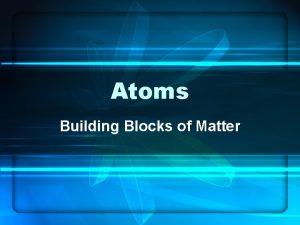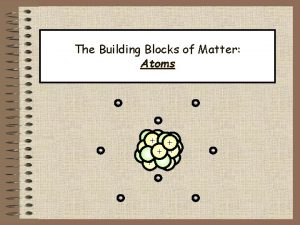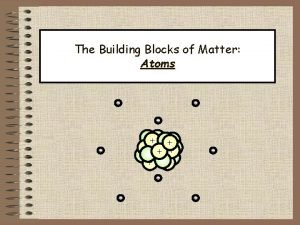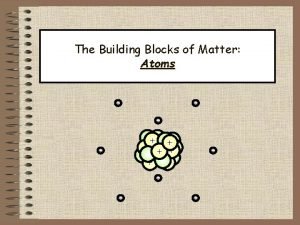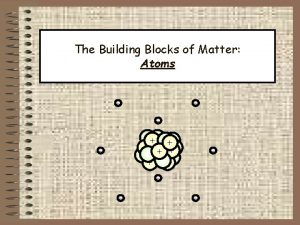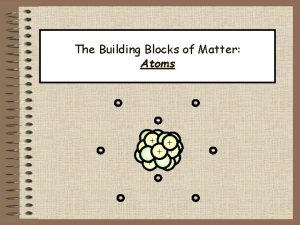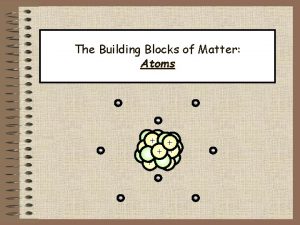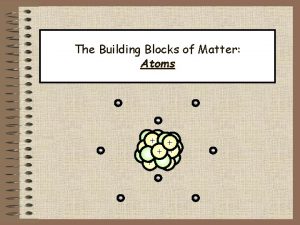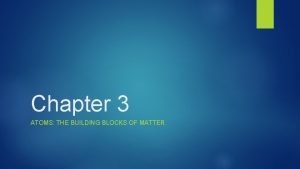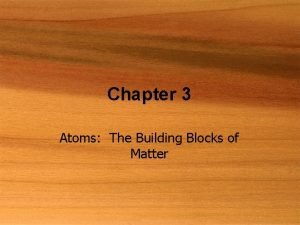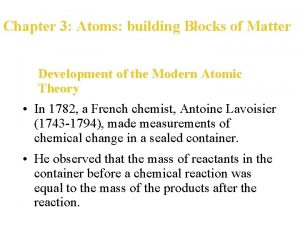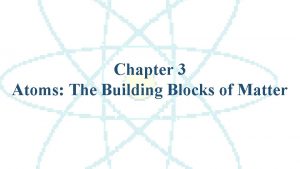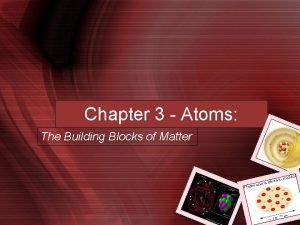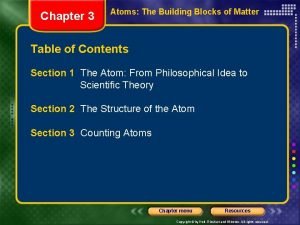Chapter 3 Atoms The Building Blocks of Matter

Chapter 3 Atoms: The Building Blocks of Matter Table of Contents Section 1 The Atom: From Philosophical Idea to Scientific Theory Section 2 The Structure of the Atom Section 3 Counting Atoms Chapter menu Resources Copyright © by Holt, Rinehart and Winston. All rights reserved.

Chapter 3 Section 3 Counting Atoms Objectives • Explain what isotopes are. • Define atomic number and mass number, and describe how they apply to isotopes. • Given the identity of a nuclide, determine its number of protons, neutrons, and electrons. • Define mole, Avogadro’s number, and molar mass, and state how all three are related. • Solve problems involving mass in grams, amount in moles, and number of atoms of an element. Chapter menu Resources Copyright © by Holt, Rinehart and Winston. All rights reserved.

Chapter 3 Section 3 Counting Atoms Atomic Number • Atoms of different elements have different numbers of protons. • Atoms of the same element all have the same number of protons. • The atomic number (Z) of an element is the number of protons of each atom of that element. Chapter menu Resources Copyright © by Holt, Rinehart and Winston. All rights reserved.

Chapter 3 Visual Concepts Atomic Number Chapter menu Resources Copyright © by Holt, Rinehart and Winston. All rights reserved.

Chapter 3 Section 3 Counting Atoms Isotopes • Isotopes are atoms of the same element that have different masses. • The isotopes of a particular element all have the same number of protons and electrons but different numbers of neutrons. • Most of the elements consist of mixtures of isotopes. Chapter menu Resources Copyright © by Holt, Rinehart and Winston. All rights reserved.

Chapter 3 Section 3 Counting Atoms Mass Number • The mass number is the total number of protons and neutrons that make up the nucleus of an isotope. Chapter menu Resources Copyright © by Holt, Rinehart and Winston. All rights reserved.

Chapter 3 Visual Concepts Mass Number Chapter menu Resources Copyright © by Holt, Rinehart and Winston. All rights reserved.

Chapter 3 Section 3 Counting Atoms Designating Isotopes • Hyphen notation: The mass number is written with a hyphen after the name of the element. uranium-235 • Nuclear symbol: The superscript indicates the mass number and the subscript indicates the atomic number. Chapter menu Resources Copyright © by Holt, Rinehart and Winston. All rights reserved.

Chapter 3 Section 3 Counting Atoms Designating Isotopes, continued • The number of neutrons is found by subtracting the atomic number from the mass number atomic number = number of neutrons 235 (protons + neutrons) 92 protons = 143 neutrons • Nuclide is a general term for a specific isotope of an element. Chapter menu Resources Copyright © by Holt, Rinehart and Winston. All rights reserved.

Chapter 3 Section 3 Counting Atoms Designating Isotopes, continued Sample Problem A How many protons, electrons, and neutrons are there in an atom of chlorine-37? Chapter menu Resources Copyright © by Holt, Rinehart and Winston. All rights reserved.

Chapter 3 Section 3 Counting Atoms Designating Isotopes, continued Sample Problem A Solution Given: name and mass number of chlorine-37 Unknown: numbers of protons, electrons, and neutrons Solution: atomic number = number of protons = number of electrons mass number = number of neutrons + number of protons Chapter menu Resources Copyright © by Holt, Rinehart and Winston. All rights reserved.

Chapter 3 Section 3 Counting Atoms Designating Isotopes, continued Sample Problem A Solution, continued mass number of chlorine-37 atomic number of chlorine = number of neutrons in chlorine-37 mass number atomic number = 37 (protons plus neutrons) 17 protons = 20 neutrons An atom of chlorine-37 is made up of 17 electrons, 17 protons, and 20 neutrons. Chapter menu Resources Copyright © by Holt, Rinehart and Winston. All rights reserved.

Chapter 3 Section 3 Counting Atoms Relative Atomic Masses • The standard used by scientists to compare units of atomic mass is the carbon-12 atom, which has been arbitrarily assigned a mass of exactly 12 atomic mass units, or 12 amu. • One atomic mass unit, or 1 amu, is exactly 1/12 the mass of a carbon-12 atom. • The atomic mass of any atom is determined by comparing it with the mass of the carbon-12 atom. Chapter menu Resources Copyright © by Holt, Rinehart and Winston. All rights reserved.

Chapter 3 Section 3 Counting Atoms Average Atomic Masses of Elements • Average atomic mass is the weighted average of the atomic masses of the naturally occurring isotopes of an element. Calculating Average Atomic Mass • The average atomic mass of an element depends on both the mass and the relative abundance of each of the element’s isotopes. Chapter menu Resources Copyright © by Holt, Rinehart and Winston. All rights reserved.

Chapter 3 Section 3 Counting Atoms Average Atomic Masses of Elements, continued Calculating Average Atomic Mass, continued • Copper consists of 69. 15% copper-63, which has an atomic mass of 62. 929 601 amu, and 30. 85% copper 65, which has an atomic mass of 64. 927 794 amu. • The average atomic mass of copper can be calculated by multiplying the atomic mass of each isotope by its relative abundance (expressed in decimal form) and adding the results. Chapter menu Resources Copyright © by Holt, Rinehart and Winston. All rights reserved.

Chapter 3 Section 3 Counting Atoms Average Atomic Masses of Elements, continued Calculating Average Atomic Mass, continued • (0. 6915 62. 929 601 amu) + (0. 3085 64. 927 794 amu) = 63. 55 amu • The calculated average atomic mass of naturally occurring copper is 63. 55 amu. Chapter menu Resources Copyright © by Holt, Rinehart and Winston. All rights reserved.

Chapter 3 Section 3 Counting Atoms Relating Mass to Numbers of Atoms The Mole • The mole is the SI unit for amount of substance. • A mole (abbreviated mol) is the amount of a substance that contains as many particles as there atoms in exactly 12 g of carbon-12. Avogadro’s Number • Avogadro’s number— 6. 022 1415 1023—is the number of particles in exactly one mole of a pure substance. Chapter menu Resources Copyright © by Holt, Rinehart and Winston. All rights reserved.

Chapter 3 Section 3 Counting Atoms Relating Mass to Numbers of Atoms, continued Molar Mass • The mass of one mole of a pure substance is called the molar mass of that substance. • Molar mass is usually written in units of g/mol. • The molar mass of an element is numerically equal to the atomic mass of the element in atomic mass units. Chapter menu Resources Copyright © by Holt, Rinehart and Winston. All rights reserved.

Chapter 3 Section 3 Counting Atoms Relating Mass to Numbers of Atoms, continued Gram/Mole Conversions • Chemists use molar mass as a conversion factor in chemical calculations. • For example, the molar mass of helium is 4. 00 g He/mol He. • To find how many grams of helium there are in two moles of helium, multiply by the molar mass. Chapter menu Resources Copyright © by Holt, Rinehart and Winston. All rights reserved.

Chapter 3 Section 3 Counting Atoms Relating Mass to Numbers of Atoms, continued Conversions with Avogadro’s Number • Avogadro’s number can be used to find the number of atoms of an element from the amount in moles or to find the amount of an element in moles from the number of atoms. • In these calculations, Avogadro’s number is expressed in units of atoms per mole. Chapter menu Resources Copyright © by Holt, Rinehart and Winston. All rights reserved.

Chapter 3 Section 3 Counting Atoms Solving Mole Problems Chapter menu Resources Copyright © by Holt, Rinehart and Winston. All rights reserved.

Chapter 3 Section 3 Counting Atoms Determining the Mass from the Amount in Moles Chapter menu Resources Copyright © by Holt, Rinehart and Winston. All rights reserved.

Chapter 3 Section 3 Counting Atoms Relating Mass to Numbers of Atoms, continued Sample Problem B What is the mass in grams of 3. 50 mol of the element copper, Cu? Chapter menu Resources Copyright © by Holt, Rinehart and Winston. All rights reserved.

Chapter 3 Section 3 Counting Atoms Relating Mass to Numbers of Atoms, continued Sample Problem B Solution Given: 3. 50 mol Cu Unknown: mass of Cu in grams Solution: the mass of an element in grams can be calculated by multiplying the amount of the element in moles by the element’s molar mass. Chapter menu Resources Copyright © by Holt, Rinehart and Winston. All rights reserved.

Chapter 3 Section 3 Counting Atoms Relating Mass to Numbers of Atoms, continued Sample Problem B Solution, continued The molar mass of copper from the periodic table is rounded to 63. 55 g/mol. Chapter menu Resources Copyright © by Holt, Rinehart and Winston. All rights reserved.

Chapter 3 Section 3 Counting Atoms Relating Mass to Numbers of Atoms, continued Sample Problem C A chemist produced 11. 9 g of aluminum, Al. How many moles of aluminum were produced? Chapter menu Resources Copyright © by Holt, Rinehart and Winston. All rights reserved.

Chapter 3 Section 3 Counting Atoms Relating Mass to Numbers of Atoms, continued Sample Problem C Solution Given: 11. 9 g Al Unknown: amount of Al in moles Solution: The molar mass of aluminum from the periodic table is rounded to 26. 98 g/mol. Chapter menu Resources Copyright © by Holt, Rinehart and Winston. All rights reserved.

Chapter 3 Section 3 Counting Atoms Relating Mass to Numbers of Atoms, continued Sample Problem D How many moles of silver, Ag, are in 3. 01 1023 atoms of silver? Chapter menu Resources Copyright © by Holt, Rinehart and Winston. All rights reserved.

Chapter 3 Section 3 Counting Atoms Relating Mass to Numbers of Atoms, continued Sample Problem D Solution Given: 3. 01 1023 atoms of Ag Unknown: amount of Ag in moles Solution: Chapter menu Resources Copyright © by Holt, Rinehart and Winston. All rights reserved.

Chapter 3 Section 3 Counting Atoms Relating Mass to Numbers of Atoms, continued Sample Problem E What is the mass in grams of 1. 20 108 atoms of copper, Cu? Chapter menu Resources Copyright © by Holt, Rinehart and Winston. All rights reserved.

Chapter 3 Section 3 Counting Atoms Relating Mass to Numbers of Atoms, continued Sample Problem E Solution Given: 1. 20 108 atoms of Cu Unknown: mass of Cu in grams Solution: The molar mass of copper from the periodic table is rounded to 63. 55 g/mol. Chapter menu Resources Copyright © by Holt, Rinehart and Winston. All rights reserved.

Chapter 3 Standardized Test Preparation Multiple Choice 1. A chemical compound always has the same elements in the same proportions by mass regardless of the source of the compound. This is a statement of A. the law of multiple proportions. B. the law of isotopes. C. the law of definite proportions. D. the law of conservation of mass. Chapter menu Resources Copyright © by Holt, Rinehart and Winston. All rights reserved.

Chapter 3 Standardized Test Preparation Multiple Choice 1. A chemical compound always has the same elements in the same proportions by mass regardless of the source of the compound. This is a statement of A. the law of multiple proportions. B. the law of isotopes. C. the law of definite proportions. D. the law of conservation of mass. Chapter menu Resources Copyright © by Holt, Rinehart and Winston. All rights reserved.

Chapter 3 Standardized Test Preparation Multiple Choice 2. An important result of Rutherford’s experiments with gold foil was to establish that A. atoms have mass. B. electrons have a negative charge. C. neutrons are uncharged particles. D. the atom is mostly empty space. Chapter menu Resources Copyright © by Holt, Rinehart and Winston. All rights reserved.

Chapter 3 Standardized Test Preparation Multiple Choice 2. An important result of Rutherford’s experiments with gold foil was to establish that A. atoms have mass. B. electrons have a negative charge. C. neutrons are uncharged particles. D. the atom is mostly empty space. Chapter menu Resources Copyright © by Holt, Rinehart and Winston. All rights reserved.

Chapter 3 Standardized Test Preparation Multiple Choice 3. Which subatomic particle has a charge of +1? A. electron B. neutron C. proton D. meson Chapter menu Resources Copyright © by Holt, Rinehart and Winston. All rights reserved.

Chapter 3 Standardized Test Preparation Multiple Choice 3. Which subatomic particle has a charge of +1? A. electron B. neutron C. proton D. meson Chapter menu Resources Copyright © by Holt, Rinehart and Winston. All rights reserved.

Chapter 3 Standardized Test Preparation Multiple Choice 4. Which particle has the least mass? A. electron B. neutron C. proton D. All have the same mass. Chapter menu Resources Copyright © by Holt, Rinehart and Winston. All rights reserved.

Chapter 3 Standardized Test Preparation Multiple Choice 4. Which particle has the least mass? A. electron B. neutron C. proton D. All have the same mass. Chapter menu Resources Copyright © by Holt, Rinehart and Winston. All rights reserved.

Chapter 3 Standardized Test Preparation Multiple Choice 5. Cathode rays are composed of A. alpha particles. B. electrons. C. protons. D. neutrons. Chapter menu Resources Copyright © by Holt, Rinehart and Winston. All rights reserved.

Chapter 3 Standardized Test Preparation Multiple Choice 5. Cathode rays are composed of A. alpha particles. B. electrons. C. protons. D. neutrons. Chapter menu Resources Copyright © by Holt, Rinehart and Winston. All rights reserved.

Chapter 3 Standardized Test Preparation Multiple Choice 6. The atomic number of an element is the same as the number of A. protons. B. neutrons. C. protons + electrons. D. protons + neutrons. Chapter menu Resources Copyright © by Holt, Rinehart and Winston. All rights reserved.

Chapter 3 Standardized Test Preparation Multiple Choice 6. The atomic number of an element is the same as the number of A. protons. B. neutrons. C. protons + electrons. D. protons + neutrons. Chapter menu Resources Copyright © by Holt, Rinehart and Winston. All rights reserved.

Chapter 3 Standardized Test Preparation Multiple Choice 7. How many neutrons are present in an atom of tin that has an atomic number of 50 and a mass number of 119? A. 50 B. 69 C. 119 D. 169 Chapter menu Resources Copyright © by Holt, Rinehart and Winston. All rights reserved.

Chapter 3 Standardized Test Preparation Multiple Choice 7. How many neutrons are present in an atom of tin that has an atomic number of 50 and a mass number of 119? A. 50 B. 69 C. 119 D. 169 Chapter menu Resources Copyright © by Holt, Rinehart and Winston. All rights reserved.

Chapter 3 Standardized Test Preparation Multiple Choice 8. What is the mass of 1. 50 mol of sodium, Na? A. 0. 652 g B. 0. 478 g C. 11. 0 g D. 34. 5 g Chapter menu Resources Copyright © by Holt, Rinehart and Winston. All rights reserved.

Chapter 3 Standardized Test Preparation Multiple Choice 8. What is the mass of 1. 50 mol of sodium, Na? A. 0. 652 g B. 0. 478 g C. 11. 0 g D. 34. 5 g Chapter menu Resources Copyright © by Holt, Rinehart and Winston. All rights reserved.
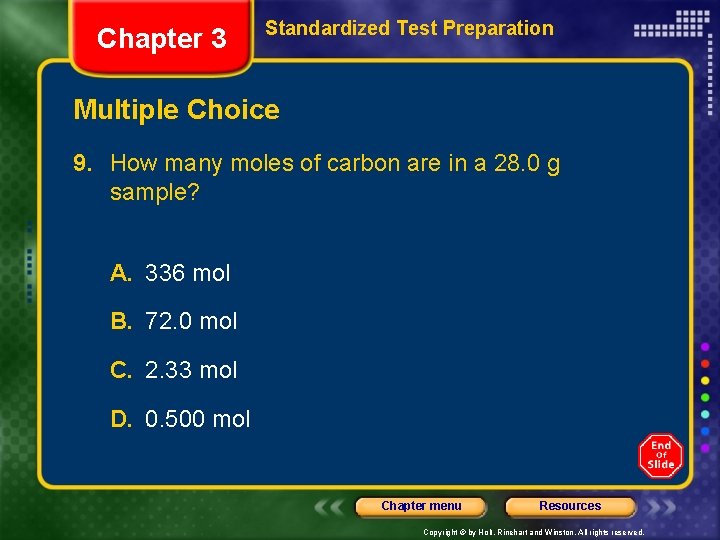
Chapter 3 Standardized Test Preparation Multiple Choice 9. How many moles of carbon are in a 28. 0 g sample? A. 336 mol B. 72. 0 mol C. 2. 33 mol D. 0. 500 mol Chapter menu Resources Copyright © by Holt, Rinehart and Winston. All rights reserved.
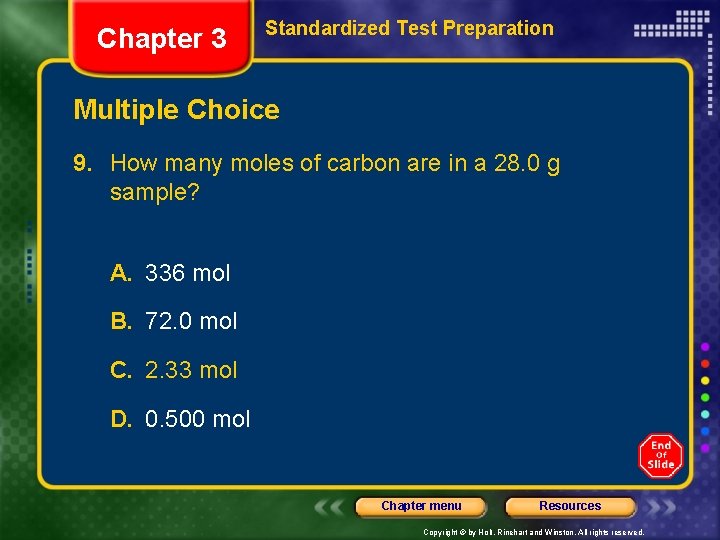
Chapter 3 Standardized Test Preparation Multiple Choice 9. How many moles of carbon are in a 28. 0 g sample? A. 336 mol B. 72. 0 mol C. 2. 33 mol D. 0. 500 mol Chapter menu Resources Copyright © by Holt, Rinehart and Winston. All rights reserved.

Chapter 3 Standardized Test Preparation Short Answer 10. Which atom has more neutrons, potassium-40 or argon-40? Chapter menu Resources Copyright © by Holt, Rinehart and Winston. All rights reserved.

Chapter 3 Standardized Test Preparation Short Answer 10. Which atom has more neutrons, potassium-40 or argon-40? Answer: Argon-40 has 22 neutrons (40 18 = 22), and potassium-40 has 21 neutrons (40 19 = 21). Chapter menu Resources Copyright © by Holt, Rinehart and Winston. All rights reserved.
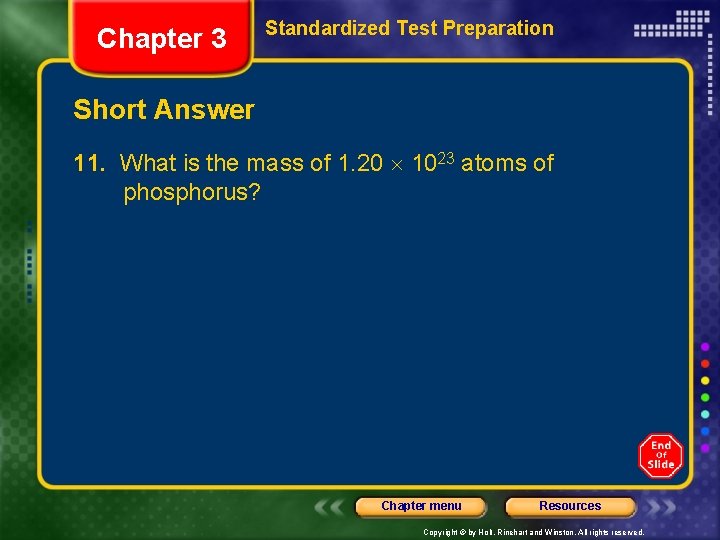
Chapter 3 Standardized Test Preparation Short Answer 11. What is the mass of 1. 20 1023 atoms of phosphorus? Chapter menu Resources Copyright © by Holt, Rinehart and Winston. All rights reserved.
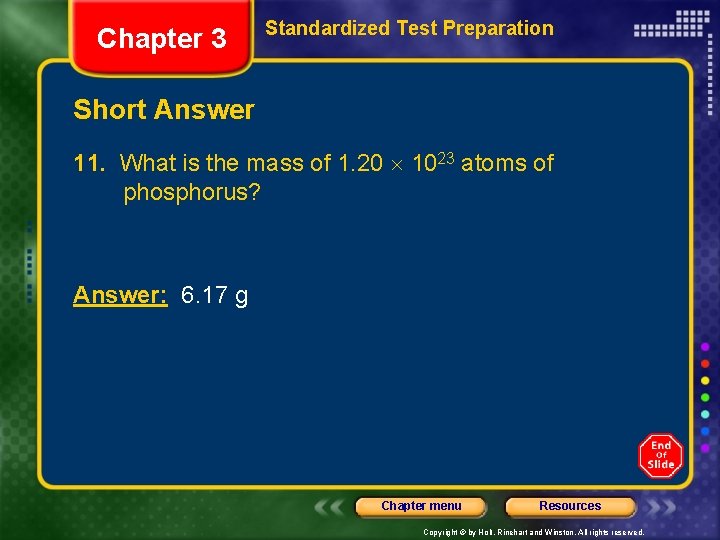
Chapter 3 Standardized Test Preparation Short Answer 11. What is the mass of 1. 20 1023 atoms of phosphorus? Answer: 6. 17 g Chapter menu Resources Copyright © by Holt, Rinehart and Winston. All rights reserved.
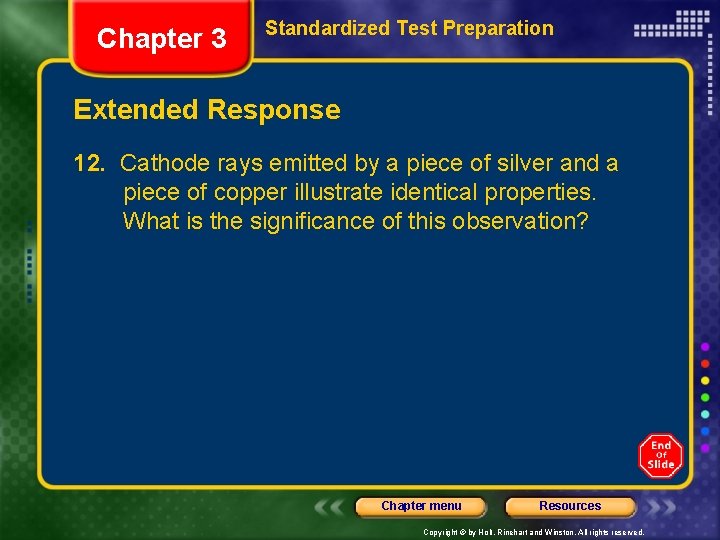
Chapter 3 Standardized Test Preparation Extended Response 12. Cathode rays emitted by a piece of silver and a piece of copper illustrate identical properties. What is the significance of this observation? Chapter menu Resources Copyright © by Holt, Rinehart and Winston. All rights reserved.

Chapter 3 Standardized Test Preparation Extended Response 12. Cathode rays emitted by a piece of silver and a piece of copper illustrate identical properties. What is the significance of this observation? Answer: All cathode rays are the same, regardless of their source. Therefore, the particles responsible for the cathode rays must be present in all atoms. The particles are electrons. Chapter menu Resources Copyright © by Holt, Rinehart and Winston. All rights reserved.

Chapter 3 Standardized Test Preparation Extended Response 13. A student believed that she had discovered a new element and named it mythium. Analysis found it contained two isotopes. The composition of the isotopes was 19. 9% of atomic mass 10. 013 and 80. 1% of atomic mass 11. 009. What is the average atomic mass, and do you think mythium was a new element? Chapter menu Resources Copyright © by Holt, Rinehart and Winston. All rights reserved.

Chapter 3 Standardized Test Preparation Extended Response 13. A student believed that she had discovered a new element and named it mythium. Analysis found it contained two isotopes. The composition of the isotopes was 19. 9% of atomic mass 10. 013 and 80. 1% of atomic mass 11. 009. What is the average atomic mass, and do you think mythium was a new element? Answer: When the average atomic mass is calculated, it is 10. 811. Because the atomic mass is the same as the atomic mass of boron, mythium was not a new element. Chapter menu Resources Copyright © by Holt, Rinehart and Winston. All rights reserved.
- Slides: 57
